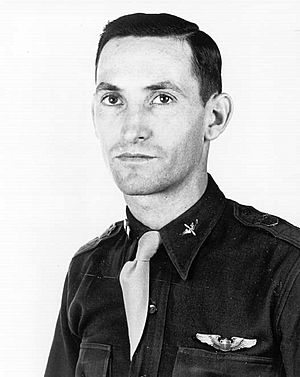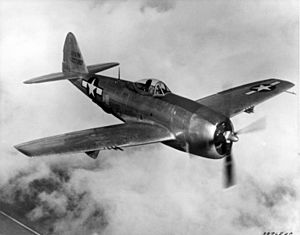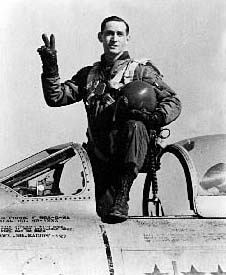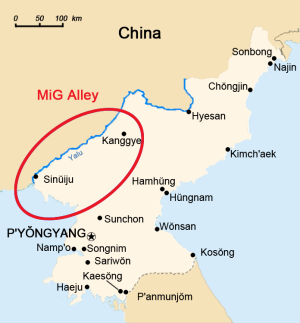George Andrew Davis Jr. facts for kids
Quick facts for kids
George Andrew Davis Jr.
|
|
|---|---|

Davis in 1945
|
|
| Nickname(s) |
|
| Born | December 1, 1920 Dublin, Texas, U.S. |
| Died | February 10, 1952 (aged 31) Yalu River, North Korea |
| Cenotaph |
City of Lubbock Cemetery,
Lubbock, Texas, U.S. |
| Allegiance | United States |
| Service/ |
|
| Years of service | 1942–1952 |
| Rank | Lieutenant colonel (posthumous) |
| Service number | 13035A |
| Unit |
|
| Commands held | 334th Fighter-Interceptor Squadron |
| Battles/wars |
|
| Awards |
|
George Andrew Davis Jr. (December 1, 1920 – February 10, 1952) was a very brave fighter pilot and "flying ace" from the United States Air Force. He was a hero in both World War II and the Korean War. A flying ace is a pilot who has shot down five or more enemy aircraft. Davis was killed in action during a mission in an area of North Korea called "MiG Alley". Because of his amazing actions in the Korean War, he was given the Medal of Honor after he died. He was also promoted to lieutenant colonel.
George Davis was born in Dublin, Texas. He joined the United States Army Air Corps in 1942. After pilot training, he went to the Pacific Ocean area during World War II. He flew in battles in New Guinea and the Philippines. He shot down seven Japanese planes. People quickly saw him as a very skilled pilot and a great shot. He was known for his "daredevil" flying style, even though he was a quiet person.
Davis didn't fight in the Korean War until late 1951. But he quickly became very successful flying the F-86 Sabre jet. He became the war's top ace, shooting down fourteen North Korean, Chinese, and Soviet planes. In his last mission, he attacked twelve Chinese MiG-15 jets by surprise. He shot down two of them before his own plane was hit. Davis was the only American flying ace to be killed in action during the Korean War.
Davis is the fourth-highest scoring American ace of the Korean War, with 14 victories. This was added to the 7 victories he had in World War II. He is one of only seven U.S. military pilots to become an ace in two different wars. He is also one of 31 U.S. pilots to have more than 20 victories in total.
Contents
Early Life and Personality
George Andrew Davis Jr. was born in Dublin, Texas, on December 1, 1920. He was one of nine children. As a child, he also lived for a short time in Maple, Texas. He went to Morton High School and then Harding College. After college, he worked on a farm with his family before joining the military.
Friends and fellow pilots described Davis as a quiet, calm, and reserved person. They also said he was a natural leader. When he was flying in combat, he became "cool and calculating." Unlike many other pilots, he did not drink or smoke. He had a calm personality, which was a surprise given his "daredevil" flying style.
Davis was married to Doris Lynn Forgason. They had three children: Mary Margaret, George III, and Charles Lynn. Charles Lynn was born after his father's death.
Military Career: World War II

On March 21, 1942, Davis joined the United States Army in Lubbock, Texas. This was soon after the U.S. entered World War II. He became an aviation cadet in the United States Army Air Corps in June. He trained at several airfields in Texas. On February 16, 1943, Davis finished his training. He became a second lieutenant in the United States Army Reserve and immediately started active duty. By this time, he had flown for 314 hours.
Davis' first job was with the 312th Bombardment Group in Louisville, Kentucky. There, he learned to fly the P-40 Warhawk fighter plane. In August 1943, his group was sent to the Pacific Ocean area.
Fighting in New Guinea
Davis was sent to Port Moresby, New Guinea. He joined the 342nd Fighter Squadron, which was part of the 348th Fighter Group. This group flew the powerful P-47 Thunderbolt fighter plane. By December, his unit moved to Finschhafen. From there, they could fight against the air forces of Japan over the Solomon Sea. Davis quickly got the nickname "Curly" because of his straight black hair. He was known for being very confident.
Davis' first combat mission was on December 31, 1943. His unit was supporting the New Britain campaign. They saw 11 Japanese planes attacking Allied ships. Davis quickly attacked a group of these planes. He shot down a Japanese D3A Val bomber. In that short battle, eight Japanese planes were destroyed.
On February 3, 1944, Davis' unit was escorting B-24 Liberator bombers. They were attacked by Japanese Nakajima Ki-43 and Kawasaki Ki-61 planes. Davis managed to attack and shoot down a Ki-61 that was attacking another American plane. The next day, Davis was promoted to first lieutenant.
For several months, Davis flew patrol and escort missions. He also took part in dive-bombing attacks on Japanese positions. On November 14, he was promoted to captain.
Battles in the Philippines
Around December 1944, Davis' unit moved to Tacloban Airport in the Philippines. On December 10, Davis' unit was protecting ships. They were attacked by four Ki-61 Tony planes. Davis climbed high and used the sun's glare to surprise two enemy planes below him. He chased them and destroyed both with his machine guns.
Davis' unit flew eight more patrol missions over Mindoro. They protected Allied ships.
On December 20, Davis was patrolling Mindoro when eight Japanese A6M Zeroes tried to ambush his flight. Davis hit the cockpit of one Zero, killing the pilot. This was his fifth victory, making him a "flying ace". Right after this, his own plane was hit by machine-gun fire. On December 24, Davis was escorting bombers to Clark Field in Manila. He shot down two more Zeroes that were attacking the bombers. Davis received a Silver Star for this brave action.
Davis flew many more missions, mostly escorting bombers or ships. He also did some ground attacks. On May 3, 1945, he was sent back to San Angelo, Texas. He helped train new pilots until the war ended.
During World War II, Davis flew 266 missions. He spent 705 hours in combat and destroyed seven Japanese planes. He earned the Silver Star, two Distinguished Flying Crosses, and nine Air Medals.
After World War II
After the war, Davis held several office jobs in the U.S. In 1946, he was offered a permanent position as a first lieutenant in the Army Air Corps. This allowed him to stay in the military. He also joined one of the Army Air Corps' aerobatic demonstration teams. These teams were like the United States Air Force Thunderbirds today.
On September 18, 1947, the United States Air Force became its own branch of the U.S. Military. Davis became a captain in the new Air Force.
Military Career: Korean War
When the Korean War started, Davis was still with the 71st Squadron. He began training on the F-86 Sabre jet, which was a very new and fast fighter plane. On February 15, 1951, he was promoted to major. In October 1951, he was sent to Korea as a fighter pilot.
Leading and Achieving Success
On November 4, 1951, Davis likely shot down a Russian-made MiG-15 jet. This was his first victory in the Korean War. On November 10, Davis became the leader of the 334th Fighter-Interceptor Squadron. His squadron moved to Kimpo Airfield to be closer to "MiG Alley" in North Korea. This was where most of the air battles happened. Davis was known for training new pilots very well. Commanders said he led by example. He was so accurate with his shooting that he earned the nickname "One Burst Davis."
On November 27, Davis led eight F-86s on a patrol. They attacked six MiG-15s. He immediately shot down one MiG, forcing the pilot to parachute out. He chased and damaged a second MiG-15, forcing that pilot to bail out too. His patrol destroyed four MiG-15s in total.
On November 30, Davis flew his 22nd mission in Korea. His flight of eight F-86s saw a large group of nine Chinese Tupolev Tu-2 bombers. They were protected by 16 Chinese Lavochkin La-11 fighters. Davis attacked the bombers four times. Even though enemy fighters attacked him, he destroyed two bombers and made the crew of a third bail out. Another group of F-86s arrived to help. As Davis' flight was leaving, one of his pilots, Raymond O. Barton, called for help. Davis went to help Barton, whose damaged plane was being attacked by 24 MiG-15s. Davis flew through their attack and hit one MiG directly, killing its leader. The other MiGs stopped their attack. Davis then helped Barton's damaged plane get back to base. Davis landed with almost no fuel left. For his actions that day, Davis received the Distinguished Service Cross. This mission made the Chinese Air Force stop all bombing missions for the rest of the war. Davis' four victories that day made him the fifth jet ace of the war. He was also the first person in U.S. military history to become an ace in two wars.
On December 5, Davis flew his 23rd mission. He spotted two MiG-15s and shot one down. Ten minutes later, he found another MiG-15 and destroyed it.
On December 13, MiG-15s attacked Davis again. He destroyed one MiG. When a second MiG tried to attack his wingman, Davis outsmarted it and shot it down. By the end of this patrol, Davis had 10 victories. This made him the first "double ace" of the war. Later that day, he spotted 50 MiGs. He surprised and destroyed one, then forced another pilot to bail out. After 30 missions in Korea, Davis had 12 victories.
After these successes, Davis was told to fly only one patrol a day. This was to keep him safer. Both the Air Force and Davis' family were worried that Chinese and Soviet pilots would try to target him because of his fame. At this point, Davis had 12 victories. The next highest-scoring aces only had six. Davis was averaging one victory for every three missions.
In January 1951, the Air Force wanted to send Davis back to the U.S. He held every record for a jet pilot. However, the Air Force couldn't find anyone else as capable to lead his squadron. Other pilots also wanted him to stay because he was such a good leader.
Aerial Victories
Throughout his career, George Davis was credited with 21 confirmed victories. He was known as an extremely talented pilot. He was especially good at hitting moving targets from far away. Davis was one of 1,297 American "aces" in World War II, with seven confirmed kills. He later became one of 41 American "aces" in the Korean War, with 14 confirmed victories. When he died, he was the top-scoring ace from the U.S. By the end of the war, he was the fourth-highest-scoring ace.
During the Korean War, Davis' achievements were very special. He was the only F-86 pilot to receive the Medal of Honor. He was also one of the few pilots who could shoot down multiple planes in a single patrol. This was very rare, and Davis did it four times. He also became a "double ace" faster than anyone else, in just 17 days.
Davis is one of only seven U.S. pilots who became an ace in both World War II (flying propeller planes) and a later war (flying jet planes).
| Date | # | Type | Location | Aircraft flown | Unit |
|---|---|---|---|---|---|
| December 31, 1943 | 1 | Aichi D3A | Arawe, New Guinea | P-47 Thunderbolt | 342 FS, 348 FG |
| February 3, 1944 | 1 | Ki-61 Hien | Wewak, New Guinea | P-47 Thunderbolt | 342 FS, 348 FG |
| December 10, 1944 | 2 | Ki-61 Hien | Cebu and Negros Islands, Philippines | P-47 Thunderbolt | 342 FS, 348 FG |
| December 20, 1944 | 1 | A6M Zero | Mindoro, The Philippines | P-47 Thunderbolt | 342 FS, 348 FG |
| December 24, 1944 | 2 | A6M Zero | Clark Field, Manila, Philippines | P-47 Thunderbolt | 342 FS, 348 FG |
| November 27, 1951 | 2 | MiG-15 | Sinanju, North Korea | F-86 Sabre | 334 FIS, 8 FIG |
| November 30, 1951 | 3 | Tupolev Tu-2 | Sahol, North Korea | F-86 Sabre | 334 FIS, 8 FIG |
| November 30, 1951 | 1 | MiG-15 | Sahol, North Korea | F-86 Sabre | 334 FIS, 8 FIG |
| December 5, 1951 | 1 | MiG-15 | Rinko-do, North Korea | F-86 Sabre | 334 FIS, 8 FIG |
| December 5, 1951 | 1 | MiG-15 | Haechang, North Korea | F-86 Sabre | 334 FIS, 8 FIG |
| December 13, 1951 | 2 | MiG-15 | Yongwon, North Korea | F-86 Sabre | 334 FIS, 8 FIG |
| December 13, 1951 | 2 | MiG-15 | Sunchon, South Korea | F-86 Sabre | 334 FIS, 8 FIG |
| February 12, 1952 | 2 | MiG-15 | Sinuiju, North Korea | F-86 Sabre | 334 FIS, 8 FIG |
| Source: | |||||
Military Awards and Honors
George Davis received many military awards for his bravery and skill:
 |
||
| Senior Pilot Badge | ||||||
| Medal of Honor | Distinguished Service Cross | |||||
| Silver Star with two bronze oak leaf clusters |
Distinguished Flying Cross with three bronze oak leaf clusters |
Purple Heart |
| Air Medal with one silver oak leaf cluster and three bronze oak leaf clusters |
Air Medal (instead of a fourth bronze oak leaf cluster) |
Air Force Presidential Unit Citation with two oak leaf clusters |
| American Campaign Medal | Asiatic-Pacific Campaign Medal with one 3⁄16" silver star and three 3⁄16" bronze stars |
World War II Victory Medal |
| National Defense Service Medal | Korean Service Medal with two 3⁄16" bronze stars |
Air Force Longevity Service Award with one oak leaf cluster |
| Philippine Liberation Medal with two 3⁄16" bronze stars |
Philippine Independence Medal | Philippine Republic Presidential Unit Citation |
| Republic of Korea Presidential Unit Citation | United Nations Korea Medal | Korean War Service Medal |
See also
- List of Korean War air aces
- List of Korean War Medal of Honor recipients
- List of World War II aces from the United States




